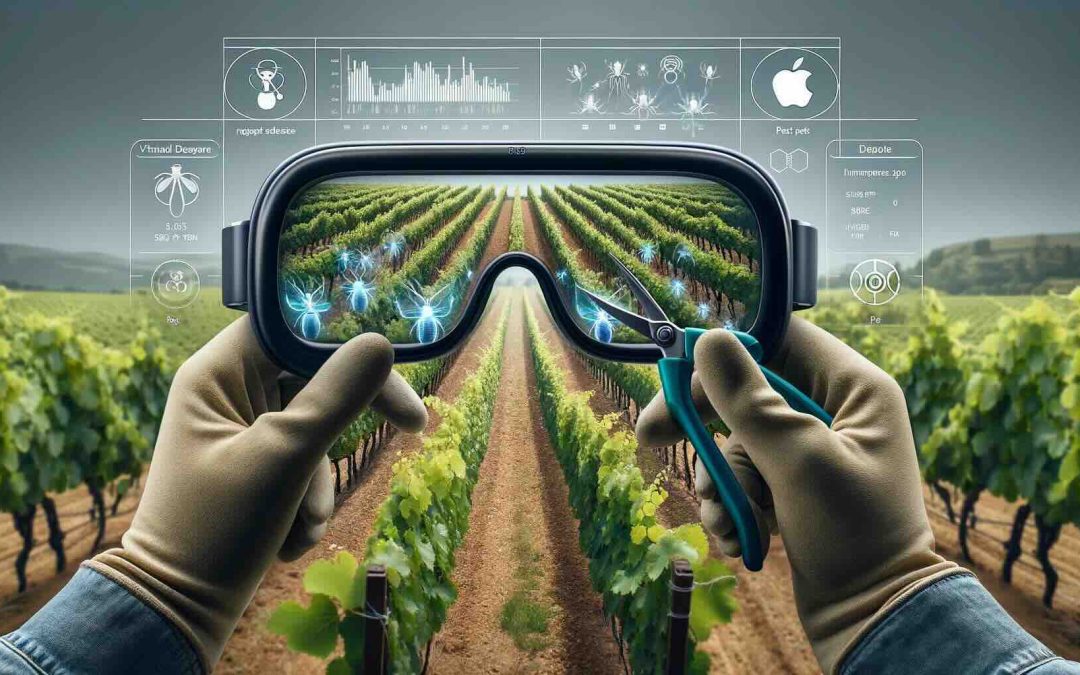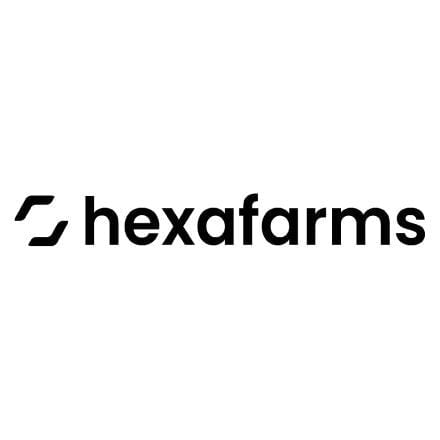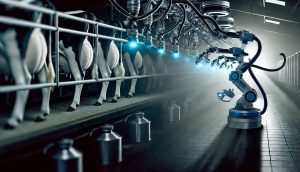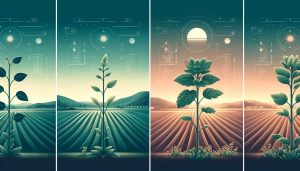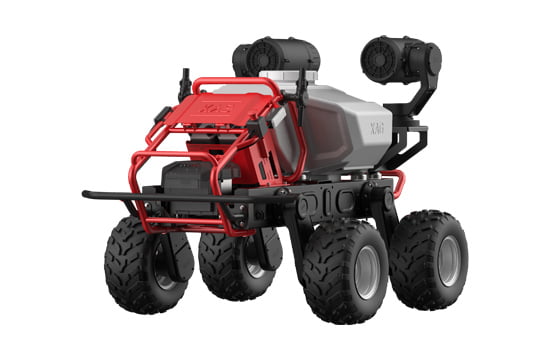David Friedberg is convinced: He is a firm believer in the transformative potential of enterprise solutions for the Apple Vision Pro Augmented Reality—or Spatial Computing—especially in the agricultural sector. As a prominent figure in the weekly ALL IN PODCAST, alongside Chamath Palihapitiya, Jason Calacanis and David Sacks, Friedberg highlights the importance of mixed reality technologies. As the CEO of the Production Board, a venture capital firm with a focus on agtech startups among others, his insights into technology-driven agribusinesses carry significant weight.
1. The arrival of Apple Vision Pro
2. Challenges in Agriculture
3. Use Cases In Agriculture
4. Companies that drive AR/VR in Agriculture
5. Specific Crops and Livestock Cases for Augmented Reality Applications
Friedberg discusses the Apple Vision Pro goggles, drawing parallels between the skepticism initially faced by the iPad and the current perceptions of the Vision Pro. He envisions a transformative role for these goggles in various sectors, particularly emphasizing their potential in agriculture. The science-oriented entrepreneur highlights the potential benefits for greenhouse workers or agronomists, noting how the goggles could revolutionize tasks like image and data capture and collection, potentially increasing productivity tenfold. He also suggests that the new technology could significantly improve sales and operational efficiency in the sector.
1. Exploring Apple Vision Pro in Agriculture
Apple Vision Pro marks a significant leap in AR/VR technology, blending the physical and digital worlds seamlessly. It’s a sophisticated device equipped with advanced sensors, cameras, and spatial awareness capabilities, designed to augment the user’s reality with digital information overlay or immerse them in a completely virtual environment. Its intuitive interface, high-resolution displays, and real-time processing power make it an ideal tool for various applications, including agriculture.
Friedberg’s optimism extends to enterprise applications for Augmented Reality devices, especially for data capture and employee training. He compares the innovation stage of this technology to the early days of the iPad, underscoring the advantages of spatial video recording for training purposes. When agronomists and agricultural sales representatices started to use ipads in the field, sales numbers went up signficantly – a game-changer.
Despite a hefty price tag of $4,000 and early sales figures of 200,000 units, Friedberg, alongside Jason Calacanis, predicts a rapid market expansion of the Apple Vision Pro. They foresee sales surpassing 100 billion units within five years, suggesting that the Vision Pro will dominate the AR space and find substantial application in enterprise settings, including agriculture.

Case study by Queppelin (with Meta’s Quest headset)
But how exactly? How exactly would spacial computing and augmented reality, maybe virtual reality be useful in agriculture and farming?
The intersection of technology and agriculture has opened new frontiers in how we approach farming, a sector traditionally dependent on manual labor and empirical knowledge. Today, the challenges facing modern agriculture—sustainability, efficiency, and labor shortages—demand innovative solutions that can revolutionize the way we cultivate and manage crops. Enter Augmented Reality (AR) and Virtual Reality (VR), two technologies that have shown immense potential in various sectors, now making their way into agriculture.
Difference between Augmented Reality (AR), Virtual Reality (VR) and Mixed Reality (XR)
Mixed Reality (XR): XR is an umbrella term that encompasses the full spectrum of the reality-virtuality continuum, including Augmented Reality (AR), Virtual Reality (VR), and everything in between. Augmented Reality: AR overlays digital information on the real world, enhancing our perception by allowing interaction with both physical and virtual elements without completely replacing the real-world environment. Virtual Reality: VR, on the other hand, immerses users in a completely digital environment, creating a fully immersive experience by disconnecting them from the physical world. XR integrates these technologies to create experiences where the real world and digital elements are seamlessly blended, enabling users to interact with both in real-time.
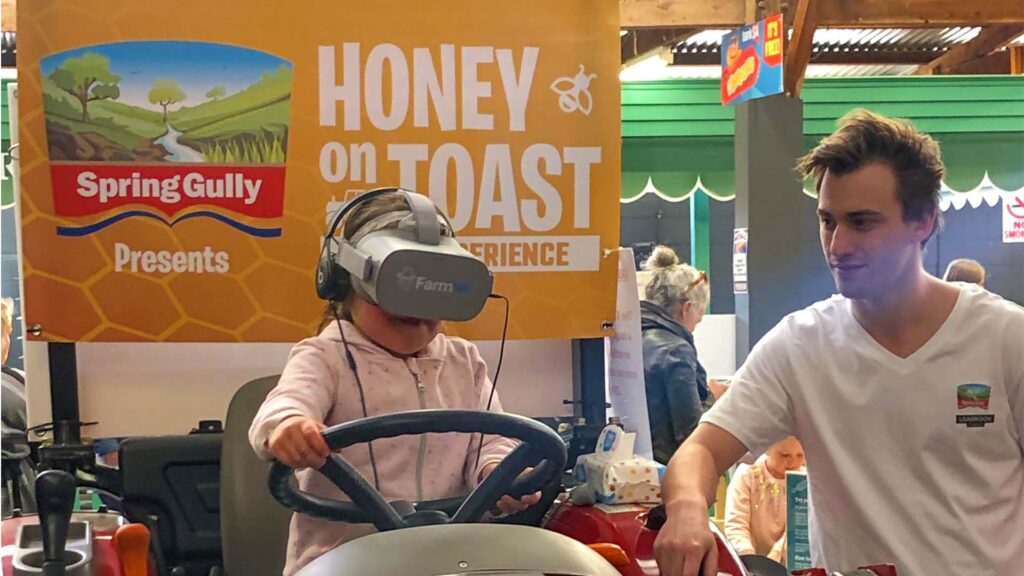
Image by Farm VR
XR technologies offer promising avenues for addressing critical challenges across various sectors, including agriculture. They enable more efficient practices, facilitate data-driven decision-making, and can potentially improve yields. This blog post explores the transformative impact of the Apple Vision Pro, an AR/VR headset, in the realm of farming. It underscores how this advanced technology, embodying the principles of XR, can enhance agricultural practices by offering a revolutionary approach to integrating digital information with the physical environment, thus paving the way for a future where farming is powered by mixed reality.
2. What We Need to Solve in Agriculture
The challenges like growing population demands, biodiversity loss, low investment in agriculture, climate change, and labor shortages are significant but can be addressed through innovative technological solutions. AR, VR, and XR offer tools for precision agriculture, training, conservation, climate adaptation, and collaboration that can help overcome these barriers and lead to more sustainable, efficient, and resilient agricultural practices.
| Challenge | Potential Solutions with AR, VR, and XR |
|---|---|
| Growing Population | AR and VR can be used for precision agriculture, enabling farmers to increase yields by optimizing planting, watering, and harvesting based on real-time data overlays. XR can support remote learning and skill development for new farmers to quickly adapt to efficient farming techniques, addressing the need for increased food production. |
| Biodiversity Loss | VR simulations can help understand the impacts of biodiversity loss and explore conservation strategies in virtual ecosystems. AR can assist in identifying plant and animal species in the field, contributing to conservation efforts and enhancing biodiversity. |
| Low Investment in Agriculture | VR and AR can attract investments by showcasing the potential of innovative farming techniques and their benefits in virtual tours or presentations. XR applications can demonstrate the ROI of sustainable practices and precision agriculture to investors remotely, making the case for increased funding in agriculture. |
| Climate Change | AR can provide farmers with information on changing weather patterns and advise on adaptive practices. VR simulations can model the impact of climate change on agriculture, aiding in developing resilient farming methods. XR can facilitate global collaboration in research and development of crops that are more resistant to climate change. |
| Labor Shortages | AR and VR training modules can quickly upskill workers, reducing the time and resources needed for training. XR technology can enable remote expert assistance, allowing experienced professionals to guide on-site workers through complex tasks without being physically present, mitigating the impact of labor shortages. |
Let’s now dive into different use cases in farming.
3. Use Cases in Agriculture: What it can be used for
This exploration into the application of Apple Vision Pro and other AR/VR technologies in agriculture highlights a future where farming is more efficient, sustainable, and accessible.
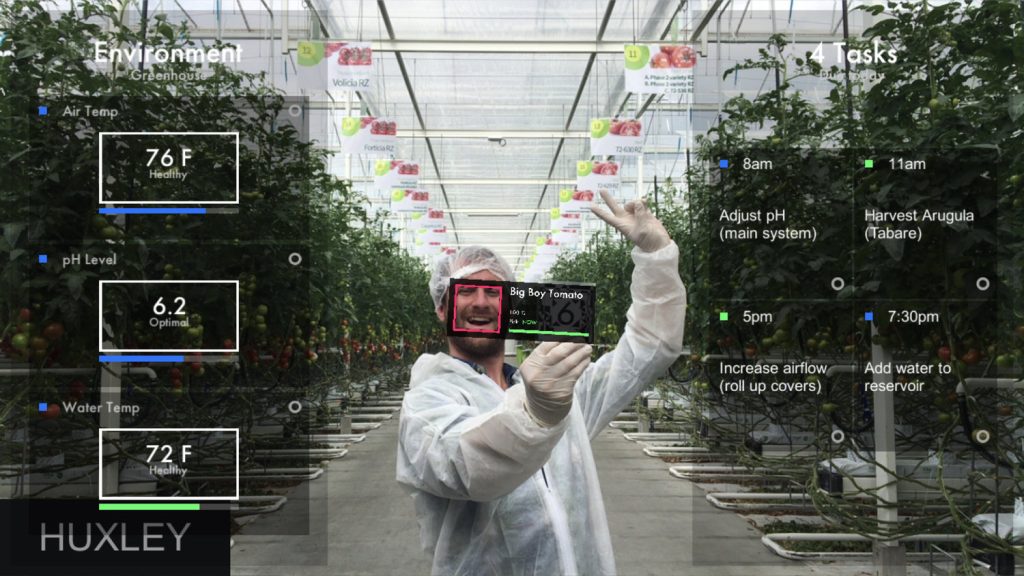
Image by Plant Vision
Impact on Accessibility and Ease of Use for Farmers
Devices like the Apple Vision Pro have the potential to democratize access to advanced farming technologies. Its user-friendly interface and immersive experience make complex data and analytics accessible to farmers, regardless of their technical expertise. By simplifying the interpretation of data and automating routine checks, it reduces the need for specialized skills, making precision agriculture more accessible to a broader audience.
- Real-time Disease Detection: Farmers can use Apple Vision Pro to scan their crops and receive instant feedback on disease symptoms, thanks to integrated AI algorithms that analyze visual data in real-time. This capability can significantly reduce response times to disease outbreaks, saving crops that might otherwise be lost.
- Remote Assistance: AR can enable experts to provide real-time guidance to farmers on the ground, offering solutions and advice through virtual overlays, significantly reducing the response time and travel costs.
- Optimizing Irrigation: Through AR overlays, the device can visualize soil moisture levels and predict water needs for different crop sections, enabling farmers to optimize their irrigation schedules and conserve water.
- Precision Agriculture: AR and VR can display vital data directly onto the physical environment, helping farmers monitor and analyze crop health, soil moisture levels, and pest infestations without the need for extensive manual checks.

Augmented Reality application with tomatoes
- Crop Variety Visualization: Before planting, farmers can visualize different crop varieties in their actual fields using VR, helping them make informed decisions about which crops might perform best in their specific conditions.
- Sales and Marketing: AR and VR can transform how agricultural products are marketed and sold. Immersive tours of farms and virtual product demonstrations can provide a unique selling proposition, engaging customers in a way that traditional marketing cannot.
- Education and Training: The immersive nature of VR is perfectly suited for education and training in agriculture. VR simulations can offer hands-on experience in farm operations, maintenance, and animal care without the physical risks, preparing individuals for real-world scenarios efficiently.
- Agronomy and Crop Management: AR applications can support soil analysis, pest identification, and precision spraying by overlaying actionable data directly onto the physical environment, enabling more precise and informed decision-making.
- Livestock Monitoring: VR technologies can be used for behavior analysis and virtual breeding programs, offering insights into livestock health and productivity without intrusive monitoring methods.
4. Companies Driving Agri Tech with AR VR XR
| Company | Technology | Detailed Use Case |
|---|---|---|
| Xarvio | AR | Collaborates with John Deere to optimize crop production and reduce environmental impacts, utilizing FIELD MANAGER for precision farming. Offers variable rate application (VRA) maps for fungicide and PGR application, leading to significant savings and yield benefits. The platform’s algorithms provide timely, precise information on plant health and in-season risks. |
| FarmVR | AR | Enhances farm safety, biosecurity, and productivity through AR wearables. Offers educational programs like the Woolworths Fresh Food Kids Discovery Tour, teaching sustainability and food origin to kids via interactive digital activities. |
| Augmenta | AR | Focuses on crop planning, yield estimation, and livestock tracking to enhance agricultural efficiency and decision-making. |
| Taranis | VR | Utilizes AI and drone-powered VR visualization for comprehensive pest management, improving crop health and reducing the need for chemical treatments. |
| Trimble Navigation | AR | Provides precision agriculture tools through AR for enhanced accuracy in field mapping, crop scouting, enabling farmers to make informed decisions for better resource management. |
| John Deere | AR | Implements AR for maintenance tutorials and operational guidance, facilitating better equipment management and productivity through innovative technology integration. |
| Agco Corporation | AR | Utilizes AR in machinery assembly and maintenance, offering interactive guides to streamline processes and reduce downtime. |
| Microsoft HoloLens | AR | Employs AR in farming for advanced training, design, and maintenance, showcasing the flexibility of AR across various applications, from crop management to equipment maintenance. |
| Queppelin | AR | Develops AR smart glasses for farmers, providing real-time weather updates, soil moisture content, and farming games, aiming to enhance the farming experience through modern technology. Additionally, Queppelin is exploring AR Smart Glasses for farming, highlighting the future of wearable technology in providing vital data overlays for farmers. |
| Think Digital | AR & VR | Offers a range of VR and AR production services for the agricultural sector, including custom VR & AR apps, farm virtual tours, and educational workshops. Aims to improve marketing, communication, and productivity in agriculture through digital storytelling and immersive learning experiences. |
| Plant Vision | AR | Utilizes AR for crop management, offering real-time data on plant health and environmental conditions, enabling farmers to make informed decisions to optimize crop health and productivity. |
| Lumination | XR | Focuses on educational programs that utilize XR technologies for teaching sustainable farming practices, helping to prepare the next generation of farmers with knowledge and skills for sustainable agriculture. |
5. Specific Augmented Reality Applications in Agriculture
Fruit Orchards
- AR for Pruning: Augmented reality can guide workers in pruning fruit trees by overlaying the optimal cutting lines on their field of view, ensuring that each cut promotes healthier growth and maximizes fruit production.
- Size Estimation: AR technology can help in estimating the size and volume of fruit directly on the tree, aiding in yield estimation and harvest planning with greater accuracy.
Vineyards
- VR for Disease Management: Virtual reality can simulate various disease scenarios, helping vineyard managers understand how to identify and react to common vine diseases.
- Grape Selection: AR can assist in the selective harvesting of grapes based on ripeness, displaying information about sugar content and optimal harvest time directly to the user.
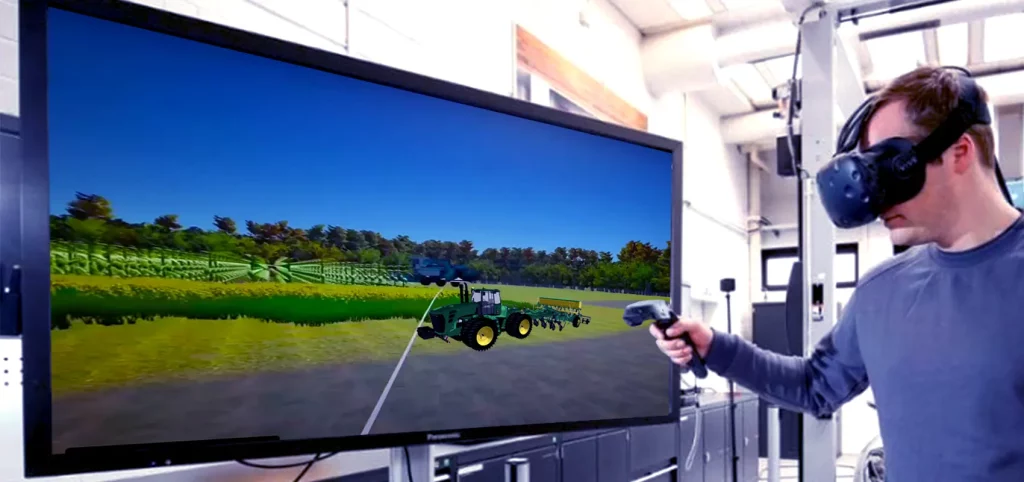
Image by Queppelin
Dairy Farms
- VR Training for Milking Procedures: Virtual reality simulations can provide a hands-on training experience for new workers, teaching them the correct milking procedures without the risk of stressing or harming the animals.
- Cow Behavior Analysis: VR can be used to study cow behavior in a virtual environment, allowing farmers to make adjustments to their real-world practices to improve welfare and productivity.
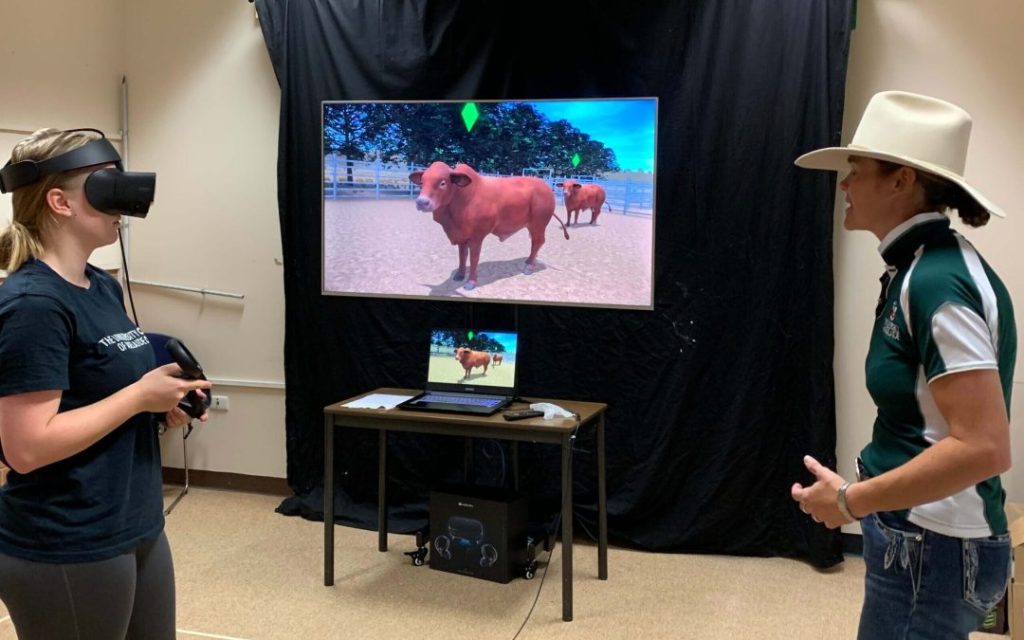
Think Digital: Large animal handling VR application
Poultry Farms
- AR for Health and Environmental Monitoring: Augmented reality can provide real-time data overlays for monitoring the health and environmental conditions of poultry farms, such as temperature, humidity, and signs of disease among the birds.

Image by Think Digital
Indoor Plants Monitoring
- Monitoring of exotic indoor plants and flowers: Farm Plant for example uses XR for monitoring exotic plants and flowers

XR usage by Farm Plant
Transforming Agriculture with Augmented and Virtual Reality
The integration of AR and VR technologies in agriculture represents a significant leap forward in how we approach farming. These technologies offer innovative solutions to longstanding challenges, such as sustainability, efficiency, and labor shortages. By providing farmers and agricultural professionals with tools for real-time disease detection, optimizing irrigation, crop variety visualization, and more, AR and VR can significantly enhance decision-making, improve yields, and make farming practices more efficient and sustainable.
As we have seen, companies like Xarvio, FarmVR, and others are already making strides in this direction, developing applications and tools that leverage AR and VR for a wide range of agricultural purposes. From immersive tours and virtual product demos for sales and marketing to VR simulations for education and training, the potential applications of these technologies are vast and varied.
The future of farming lies in the adoption and integration of these technologies. As more agricultural professionals begin to explore and adopt AR and VR solutions, we can expect to see a transformation in the industry that not only improves productivity and sustainability but also makes agriculture more accessible and appealing to the next generation.

